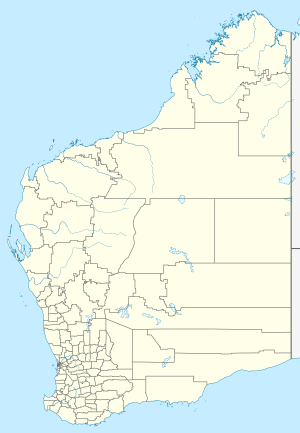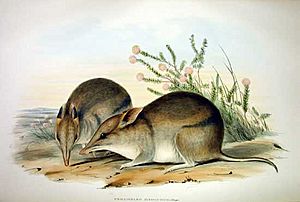Faure Island facts for kids
Faure Island is a special island in Western Australia. It covers about 58 square kilometers. The island is a pastoral lease (meaning it can be used for farming) and a nature reserve. It sits east of the Francois Peron National Park in Shark Bay. The island is surrounded by the Shark Bay Marine Park and the Shark Bay World Heritage Site. Today, the Australian Wildlife Conservancy (AWC) owns and manages Faure Island as a wildlife sanctuary.
Contents
Island History
The island got its European name in 1801 from a French explorer named Nicolas Baudin. He named it after Pierre Faure, who was a geographer on Baudin's ship, Le Naturaliste.
In the past, people used the island for farming. In 1873, Charles Edward Broadhurst was granted a lease. Later, in 1883, WD Moore & Coy also got a lease. For most of the 1900s, the Hoult family raised sheep and goats on the island.
In 1999, the Hoults sold their lease to the AWC. The AWC then removed over 3,400 sheep from the island. This helped the island become a better home for native wildlife.
Island Landscape and Weather
What Faure Island Looks Like
Faure Island has mostly red and white sandy plains. You can also find sand dunes. In lower areas, there are flat, muddy spots called claypans. The highest point on the island is 26 meters above sea level. Some parts of the coast have cliffs made of limestone and red sand.
Plants on the Island
Most of the plants on Faure Island are low shrubs. A common one is called Acacia ramulosa. You can also find other types of shrublands, like mallee. There are also spinifex grasslands and areas with samphire and Atriplex shrubs. Along the coast, you can see mangrove trees.
Climate and Rainfall
The weather on Faure Island is mostly dry. Summers are hot and dry, while winters are mild. Rain doesn't fall often, but when it does, it's usually in winter. On average, the island gets about 222 millimeters of rain each year. Sometimes, Cyclones can bring rain during summer and autumn.
Amazing Wildlife
Birds of Faure Island
Faure Island is a very important place for many seabirds to have their babies. It's also a key stop for migratory waders. These birds use a special route called the East Asian - Australasian Flyway. Because of its importance, Faure Island and nearby Pelican Island are part of an Important Bird Area (IBA).
This IBA helps protect breeding groups of fairy terns. It also supports over 1% of the world's population of red-necked stints and pied oystercatchers. When combined with another nearby IBA, it helps protect more than 1% of the world's pied cormorants.
Mammals and Reintroduction Efforts
Sadly, the native mammals that once lived on Faure Island disappeared. This happened because of farm livestock and wild feral cats. However, scientists found old bones (sub-fossils) that showed which native mammals used to live there.
Because of this evidence, several native mammals have been brought back to the island. These include the boodie, the Shark Bay mouse, the banded hare-wallaby, and the western barred bandicoot. These reintroductions help bring the island's ecosystem back to its natural state. An attempt to reintroduce the greater stick-nest rat was not successful.
Marine Life Around the Island
Faure Island is located within the Shark Bay Marine Park. It is very close to the Wooramel Seagrass Bank. It is also next to the Faure Sill sandbank. This sandbank plays a big role in creating the special conditions found in the Hamelin Pool Marine Nature Reserve.



